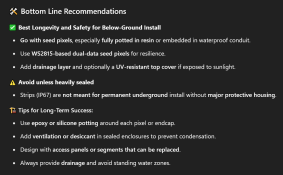thewanderingpine
Senior elf
- Joined
- Mar 13, 2021
- Messages
- 522
So partially inspired by this video:
View: https://www.youtube.com/watch?v=d-t0tVdP6E0
I'm thinking about doing some in/on ground permanent LED installs. I have 3 choices but I'm not really sure about longevity/water-ingress/etc.
So perhaps the choice is really between the top 2 -- and if I decide to go for white then I pick the 2805. Any thoughts on leaving LED's at/below ground level year-round? Would you go seed or strip for this?
View: https://www.youtube.com/watch?v=d-t0tVdP6E0
I'm thinking about doing some in/on ground permanent LED installs. I have 3 choices but I'm not really sure about longevity/water-ingress/etc.
- 12V Dual Data Seed pixels (probably at 30mm spacing)
- 12V WS2815 IP67 strip at 30/m
- 12V WS2805 IP67 strip
So perhaps the choice is really between the top 2 -- and if I decide to go for white then I pick the 2805. Any thoughts on leaving LED's at/below ground level year-round? Would you go seed or strip for this?


